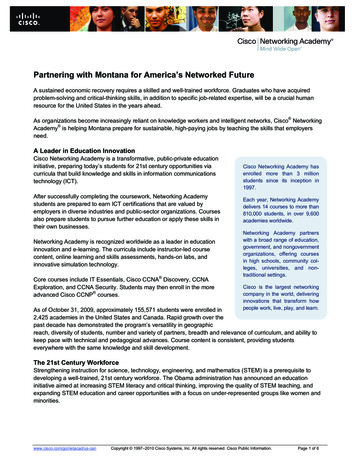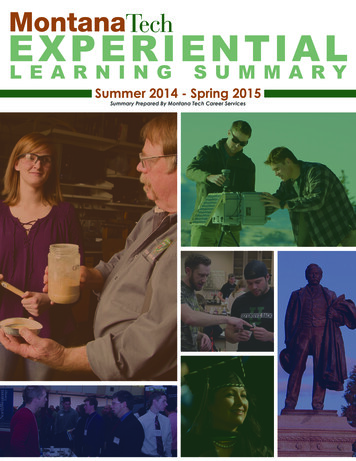
Transcription
Partnering with Montana for America’s Networked FutureA sustained economic recovery requires a skilled and well-trained workforce. Graduates who have acquiredproblem-solving and critical-thinking skills, in addition to specific job-related expertise, will be a crucial humanresource for the United States in the years ahead.As organizations become increasingly reliant on knowledge workers and intelligent networks, Cisco NetworkingAcademy is helping Montana prepare for sustainable, high-paying jobs by teaching the skills that employersneed.A Leader in Education InnovationCisco Networking Academy is a transformative, public-private educationinitiative, preparing today’s students for 21st century opportunities viacurricula that build knowledge and skills in information communicationstechnology (ICT).Cisco Networking Academy hasenrolled more than 3 millionstudents since its inception in1997.After successfully completing the coursework, Networking Academystudents are prepared to earn ICT certifications that are valued byemployers in diverse industries and public-sector organizations. Coursesalso prepare students to pursue further education or apply these skills intheir own businesses.Each year, Networking Academydelivers 14 courses to more than810,000 students, in over 9,600academies worldwide.Networking Academy is recognized worldwide as a leader in educationinnovation and e-learning. The curricula include instructor-led coursecontent, online learning and skills assessments, hands-on labs, andinnovative simulation technology.Networking Academy partnerswith a broad range of education,government, and nongovernmentorganizations, offering coursesin high schools, community colleges, universities, and nontraditional settings.Core courses include IT Essentials, Cisco CCNA Discovery, CCNAExploration, and CCNA Security. Students may then enroll in the moreadvanced Cisco CCNP courses.Cisco is the largest networkingcompany in the world, deliveringinnovations that transform howpeople work, live, play, and learn.As of October 31, 2009, approximately 155,571 students were enrolled in2,425 academies in the United States and Canada. Rapid growth over thepast decade has demonstrated the program’s versatility in geographicreach, diversity of students, number and variety of partners, breadth and relevance of curriculum, and ability tokeep pace with technical and pedagogical advances. Course content is consistent, providing studentseverywhere with the same knowledge and skill development.The 21st Century WorkforceStrengthening instruction for science, technology, engineering, and mathematics (STEM) is a prerequisite todeveloping a well-trained, 21st century workforce. The Obama administration has announced an educationinitiative aimed at increasing STEM literacy and critical thinking, improving the quality of STEM teaching, andexpanding STEM education and career opportunities with a focus on under-represented groups like women ight 1997–2010 Cisco Systems, Inc. All rights reserved. Cisco Public Information.Page 1 of 6
Educators have placed considerable emphasis on the science and math components of the STEM curricula. Buttechnology and engineering are equally vital. In particular, ICT investments are expected to play a major role ingenerating stable, high-paying jobs and boosting the nation’s GDP. In addition, a workforce that is well-schooledin ICT and engineering can help spur innovation across many industries, which in turn opens up additionalbusiness opportunities to fuel productivity and economic growth.“Reaffirming and strengthening America's role as the world's engine of scientificdiscovery and technological innovation is essential to meeting the challenges of thiscentury. That's why I am committed to making the improvement of STEM educationover the next decade a national priority.” —President Barack Obama, 11/23/09Networking Academy puts an emphasis on understanding what skills will be required in future job markets.Networking knowledge will be especially important in critical areas such as green technologies, healthcare, smartenergy grids, and the push toward universal broadband deployment. Networking Academy utilizes an educationinfrastructure that ensures curricula will evolve to meet STEM and future learning requirements.State-of-the-Art Learning EnvironmentThe instructional approach at Networking Academy encourages student engagement, enhancing the student’sability to synthesize learning and apply it in other contexts. Four skill areas identified by education researchers ascritical for 21st century workers have been integrated into the course content: Problem solving and decision making: Students practice and test their knowledge by configuring andtroubleshooting networks using hands-on labs and simulation software. Creative and critical thinking: Students understand the how and why of networking by combininghands-on learning with conceptual and analytical exercises. Collaboration, communication, and negotiation: Students acquire teamwork and career-ready skills asthey perform lab exercises and engage in business scenarios. Intellectual curiosity and information handling: Coursework helps students develop the ability to find,select, structure, and evaluate information. Real-world case studies give students the opportunity todevelop cutting-edge problem-solving techniques.Spotlight on Community CollegesA unique feature of these institutions is their linkage with business and industry, and hence their integration intoeconomic development. Community colleges are working to align their curricula, certifications, and degrees withnew ICT jobs through Networking Academy implementations. In the United States, more than 50% of allcommunity colleges offer Networking Academy courses.According to researchers, students today are faced with high tuition costs, a weak economy, and increasedcompetition for admission to four-year colleges. They are more likely than at any other point in history to attendcommunity college. As a result, community colleges have experienced a spike in enrollment. In July 2009, theObama administration proposed a 12 billion plan called the American Graduation Initiative, aimed at supportingcommunity colleges by funding job training and retraining programs.www.cisco.com/go/netacad/us-canCopyright 1997–2010 Cisco Systems, Inc. All rights reserved. Cisco Public Information.Page 2 of 6
As an example of how these institutions are responding to the challenge, Moraine Valley Community College inthe Chicago area is leading the Center for System Security and Information Assurance (CSSIA), a consortium ofseven academic institutions in five states, dedicated to developing and evaluating cyber-security curricula, andoffering training programs to community college and university faculty, secondary school faculty, and studentsacross the region. A Cisco Networking Academy training center was established at Moraine in 1998, andacademy courses are an integral part of the curricula. CSSIA has developed nine undergraduate courses, ninegraduate courses, and a variety of workshops that can be used as models by other institutions.The Data Behind the DemandTables 1 and 2 outline the growth and projected demand for ICT-related careers in the nation overall, and in thestate of Montana.Table 1.Projection of Select ICT Occupations in the United r Support mputer Systems k and Computer 27,850Network Systems and DataCommunications uter and InformationSystems tionalEmploymentas of May 20082EmploymentOccupationTable 2.3as of May 2008220062016Number%AverageAnnualOpeningsComputer Support Specialists1111131920818.7551,240Computer Systems Analysts68494225837.744650Network and Computer SystemsAdministrators66786019328.934780Network Systems and DataCommunications Analysts3485361885426370Computer and InformationSystems loymentProjection of Select ICT Occupations in Montana3Occupation1Employment ChangeEmployment ChangeSource: U.S. Department of Labor, Bureau of Labor Statistics, www.bls.gov/emp/emptabapp.htm, based on data available on of Oct 31, 2008Source: U.S. DoL, BLS, May 2008 State Occupational Employment and Wage Estimates, : U.S. DoL, BLS, Projections Central, ad/us-canCopyright 1997–2010 Cisco Systems, Inc. All rights reserved. Cisco Public Information.Page 3 of 6
The Impact in MontanaThe partnership between Cisco Networking Academy and Montana has touched the lives of 4,411 students andgenerated an estimated contribution valued at 3,086,757 to education in the state. Tables 3-4 provide detailedinformation on the current academies, curricula, and education levels in the state.Table 3. Cisco Networking Academy in Montana1Students675Female students20%Distinct cumulative students (having successfully completed at least one course)4,411Academies18Instructors26Education Level(students/academies at more than one ed levelare distributed 22%0%Curricula3(students/academies that take/teach multiplecurricula are counted more than once)ITECCNA 1, 2CCNA 3, ademies17%72%39%17%5Contribution value (estimated cumulative value to academies, including donations and discounts)2 3,086,7571Source: MRE FULL Package of Quarterly Metrics 10.31.09 v1.xlsIncludes community-based organizations, middle schools, military, nontraditional educational settings, and post-graduate institutions3Source: MRE reports 4075 MASTER P51 v2 with Country Totals.xlsx4Includes CCNA Security, CCNP, Security, Wireless, IP Telephony, Java, UNIX and Panduit Network Infrastructure Essentials (PNIE)5Source: MRE report MASTER IN-KIND CONTRIBUTION for USCAN as of 10.31.09 v1.xlsx2Table 4.Active Academies in Montana6Active academies are defined as those that have taught a class with at least 3 distinct student assessments, or adopted a new curriculum,within the last 12 months.Number of DistrictsWith Networking AcademiesWithout Networking Academies% Penetration110100%Congressional District – At LargeHelena High School (Helena)Sunburst High School (Sunburst)Augusta School District (Augusta)Miles Community College (Miles City)Troy High School (Troy)Belt (Belt)*Montana State University - Billings Cot(Billings)UM College of Technology (Missoula)Billings Career Center (Billings)University of Montana-Helena (Helena)Browning High School (Browning)*Montana State University - Great Falls(Great Falls)University of Montana-Western (Dillon)Central Montana Cisco Academy(Lewistown)*Montana Tech of the University ofMontana (Butte)University of Montana-Missoula(Missoula)Great Falls High (Great Falls)www.cisco.com/go/netacad/us-canWhitehall High School (Whitehall)Copyright 1997–2010 Cisco Systems, Inc. All rights reserved. Cisco Public Information.Page 4 of 6
* Indicates Cisco Networking Academy Training Center6Source: MRE/Academy Connection, Congressional Report VLOOKUP December 08 2009 Final ch1.xlsxStudent and Community ImpactAfter working in the Antarctic for 11 years providing logistical support to research scientists, Sarah Gundlachwas ready to master something new. When she returned home to Frenchtown, Montana, Sarah completedseveral courses at a local technical college. One of these was a one-week program on routers and switchesduring which she learned about Cisco Networking Academy and Cisco certifications. She was so interested inthe material that after the one-week course, she actually tried to pass the Cisco CCNA exam. “Imagine myscore after one week” says Sarah. Nevertheless, she was hooked and soon enrolled in Networking Academy atthe University of Montana at Missoula. Two years later, Sarah took the exam again, passed, and earned herCisco CCNA certification.Sarah credits her successful experience in Networking Academy to her instructors, the text books, the onlinecurriculum, and the hands-on lab experience. “They were all important factors” says Sarah. The labs enabledher to practice router and switch configurations and the books were so valuable that she would often get up at 4a.m. to read and study.Sometimes getting to class in Frenchtown, which is located in the rugged Montana countryside,could be challenging. The eight miles of unmaintained dirt road could be icy or impassable due tosnow or fallen trees. Sarah put her experiences living in Greenland and the Antarctic to good useand ensured she arrived for classes on time.When she was enrolled at Networking Academy, Sarah was living in a smallsolar-powered cabin, without running water, which she built herself. She was alsorunning her 160-acre farm and working as an independent technology contractorproviding local area network support to small local businesses.Sarah insists that her academy instructors, Penny Jakes and Rhonda Tabish, kept her focused. “Penny is avery good teacher,” says Sarah “she kept in touch with each person to see what they were going through.Penny must have seen something in me and knew I could do better.”It must have been apparent to her instructors that Sarah was capable of some pretty extraordinary things.When she was enrolled at Networking Academy, Sarah was living in a small solar-powered cabin, withoutrunning water, which she built herself. She was also running her 160-acre farm and working as an independenttechnology contractor providing local area network support to small local businesses. She did all this afterbeating kidney cancer in 2003. Clearly, Sarah’s positive attitude, dedication, and strong work ethic were factorsin her success.Now that she’s earned her Cisco CCNA certification, Sarah is searching for her dream job as a networkingprofessional and is eager to work as part of an information technology team. “Networking Academy hasprovided a very strong background” asserts Sarah. During interviews, Sarah is pleased to be able say that shehas actually used the equipment in a lab environment instead of just having simulator experience. Her futureplans include becoming a network engineer with Cisco CCNP credentials, potentially specializing in VoIP.www.cisco.com/go/netacad/us-canCopyright 1997–2010 Cisco Systems, Inc. All rights reserved. Cisco Public Information.Page 5 of 6
When asked what she enjoyed most about Networking Academy, Sarah replies “the challenge it wasdefinitely the longest time I ever studied and focused on earning a certification. Passing the Cisco CCNA examwas the reward for the hard work.”During interviews, Sarah is pleased to be able say that she has actually used theequipment in a lab environment instead of just having simulator experience.Her advice to others who are interested in Networking Academy is “ stay dedicated to it and don’t stray.” Inaddition, she suggests “ learn the material, don’t just memorize it. Don’t get discouraged keep at it, andpractice, practice, practice.”Learn MoreFor additional information, impact stories, and Cisco Networking Academy contacts in your area, visit ourwebsite: tacad/us-canCopyright 1997–2010 Cisco Systems, Inc. All rights reserved. Cisco Public Information.Page 6 of 6
A sustained economic recovery requires a skilled and well-trained workforce. Graduates who have acquired . (Missoula) University of Montana-Helena (Helena) . Page 5 of 6 * Indicates Cisco Networking Academy Training Center 6 Source: MRE/Academy Connection, l_ch1.xlsx Student and Community Impact











